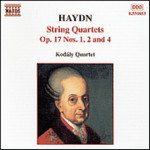
Haydn: String Quartets Op. 17, Nos. 1, 2 and 4
 $25.00
Out of Stock
$25.00
Out of Stock2-4 weeks add to cart
JOSEPH HAYDN
Haydn: String Quartets Op. 17, Nos. 1, 2 and 4
Kodaly Quartet
[ NAXOS / CD ]
Release Date: Saturday 27 October 2007
This item is currently out of stock. We expect to be able to supply it to you within 2 - 4 weeks from when you place your order.
Joseph Haydn was born in the village of Rohrau in 1732, the son of a wheelwright. Trained at the choir-school of St. Stephen's Cathedral in Vienna, he spent some years earning a living as best he could from teaching and playing the violin or keyboard, and was able to learn from the old musician Porpora, whose assistant he became.
Haydn's first appointment was in 1759 as Kapellmeister to a Bohemian nobleman, Count von Morzin. This was followed in 1761 by employment as Vice-Kapellmeister to one of the richest men in the Empire, Prince Paul Anton Esterházy, succeeded on his death in 1762 by his brother Prince Nikolaus. On the death in 1766 of the elderly and somewhat obstructive Kapellmeister, Gregor Werner, Haydn succeeded to his position, to remain in the same employment, nominally at least, for the rest of his life.
On the completion under the new Prince of the magnificent palace at Esterháza, built on the site of a former hunting-lodge set on the Hungarian plains, Haydn assumed command of an increased musical establishment. Here he had responsibility for the musical activities of the palace, which included the provision and direction of instrumental music, opera and theatre music, and music for the church. For his patron he provided a quantity of chamber music of all kinds, particularly for the Prince's own peculiar instrument, the baryton, a bowed string instrument with sympathetic strings that could also be plucked.
On the death of Prince Nikolaus in 1790, Haydn was able to accept an invitation to visit London, where he provided music for the concert season organized by the violinist-impresario Salomon. A second successful visit to London in 1794 and 1795 was followed by a return to duty with the Esterházy family, the new head of which had settled principally at the family property in Eisenstadt, where Haydn had started his career. Much of the year, however, was to be spent in Vienna, where Haydn passed his final years, dying in 1809, as the French armies of Napoleon approached the city yet again.
Haydn lived during the period of the eighteenth century that saw the development of instrumental music from the age of Bach and Handel to the era of the classical sonata, with its tripartite first-movement form and complementary three or four movements, the basis now of much instrumental composition. The string quartet itself, which came to represent classical music in its purest form, grew from a genre that was relatively insignificant, at least in name, the Divertimento, into music of greater weight, complexity and substance, although Haydn, like any great master, knew well how to conceal the technical means by which he achieved his ends. The exact number of string quartets that Haydn wrote is not known, although he himself listed some 83. The earlier of these, often under the title Divertimento, proclaim clearly enough their origin and purpose. Haydn's last quartet, Opus 103, started in 1803, remained unfinished and coincided with the appearance of quartets of a new and original kind, from Haydn's recalcitrant and ungrateful pupil Beethoven. Haydn himself once claimed to have discovered the string quartet by accident. The discovery, if such it was, has continued to have a far-reaching effect on the development of Western music.
Tracks:
String Quartet in F major, Op. 17, No.2, Hob. III: 26
String Quartet in E major, Op. 17, No.1, Hob. III: 25
String Quartet in C minor, Op. 17, No.4, Hob. III: 28


